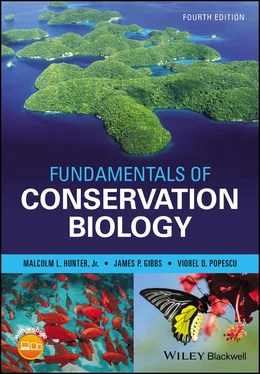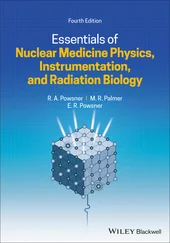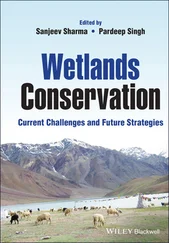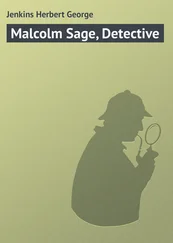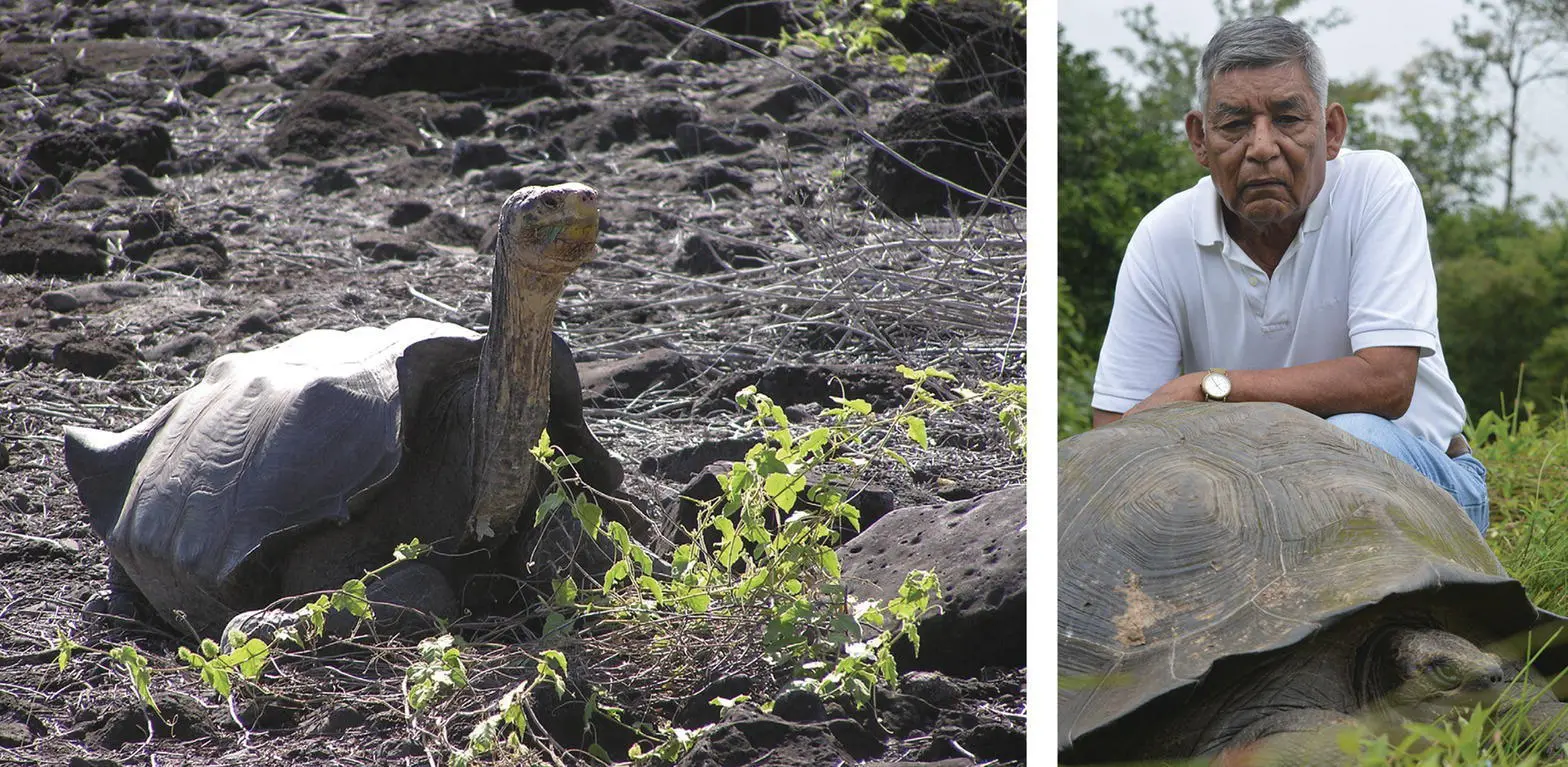
Figure 1.6 This Española tortoise was among the very first repatriated to the island as a small hatchling some 25–30 years ago once goats had been removed and the island’s habitat restored. It is likely one of the tortoises now responsible for the new hatchlings appearing again on the island, representing the first reproduction in this population in many decades. At right is Mr Fausto Llerena, a park guard and tortoise keeper of over 40 years, who largely is responsible for figuring out how to breed Galapagos tortoises in large numbers in captivity.
(James P. Gibbs, author)
The population is again secure and sustaining itself. But not all is well. The vegetation has recuperated rapidly now that the goats are gone, but perhaps too rapidly as it has become impenetrable in many areas, even blocking movements by the newly arrived tortoises. The slow‐growing cacti remain scattered and rare but they are showing signs of recovery, now that the tortoises are back to disperse their seeds.
The Española tortoises, once abandoned and quietly relegated to extinction, have returned to their native ground. All 15 surviving tortoises found 60 years ago are still alive in June 2020 and all were retired back to their original home on Española to be with their hundreds of offspring and “grand‐offspring.” They are now essentially taking care of themselves. Humans can step back out of the picture, after being a destructive force and then a healing one, and let the tortoises and their ecosystem resume interacting as they did for thousands of years previously. Conservation has succeeded. It was accomplished by a cadre of dedicated individuals, mostly Ecuadorian park managers and scientists with some foreign support, working with scarce funds. Because of the program’s success, Española tortoises are now being liberated on another island – nearby Santa Fe Island that lost its tortoises 200 years ago – to restore the ecological role of tortoises there and develop an “insurance” colony for Española tortoises. It is an example of the awesome power of humans to control the fate of wild life. It is also an example of how we can be both agents of destruction and benevolent stewards of restoration. This book seeks to explore these issues with you in much greater detail and to provide guidance on achieving positive outcomes for the many creatures around the world that, like the Española tortoises, are still struggling to survive.
1 Primary sources for this section were: Marquez et al. (1991), Milinkovitch et al. (2004), Gibbs et al. (2014), and personal observations.
People who care about nature and the natural resources we obtain from nature, such as clean air and clean water, come with many labels: conservationists and preservationists, environmentalists and ecologists. Although these people share many goals, their priorities can differ. For example, conservationists advocate the careful use of natural resources, whereas environmentalists often emphasize maintaining an uncontaminated environment. The history of conservation has a recurring theme: people being forced to limit their use of natural resources more and more as human populations grow and technological sophistication increases. Conservation history is marked by practices and laws regulating our use of natural resources, but more fundamental is the evolution of our ethical attitudes toward nature and its intrinsic and instrumental values. Three ethical positions underpin our motivation and practices to conserve biodiversity: (1) the Romantic‐Transcendental Preservation Ethic (briefly, nature is best used for spiritual purposes); (2) the Resource Conservation Ethic (nature is natural resources to be carefully developed for human purposes); and (3) the Evolutionary‐Ecological Land Ethic (people are part of nature and have both the right to change it and a responsibility for respecting the intrinsic value of other species and ecosystems in general). Conservation biology is the applied science of maintaining the Earth’s biological diversity. It differs from basic biologic sciences because it reaches out to economics, law, education, politics, philosophy, and other subjects that shape the human world within which conservation must operate. It differs from traditional natural resource sciences because it places relatively greater emphasis on all forms of life and their intrinsic value, compared with other natural resource sciences, which typically focus on relatively few species with high instrumental (usually economic) value.
A comprehensive world history of conservation would be voluminous but some succinct overviews are available (Hughes 2009; Simmons 2008). If you want more depth there are whole encyclopedias (Krech et al. 2004), even one covering just the United States (Brosnan 2011). Many books cover certain times, phenomena, and places; for example, the sixteenth to eighteenth centuries (Richards 2003), the twentieth century (McNeill 2000), European colonization (Grove 1995), collapse of civilizations (Diamond 2005), Canada (MacDowell 2012), Latin America (Miller 2007), the Mediterranean (Hughes 2005), and the United States (Merchant 2007). Also see the journal Environmental History . Articles by Soulé (1985), Callicott (1990), and Jacobson (1990) form a foundation for the latter parts of the chapter and merit further reading. For relevant websites, check out the Society for Conservation Biology’s website at conbio.org and some of the major international conservation groups at www.iucn.org, wwf.org, www.nature.org, www.conservation.org, and www.worldwildlife.org.
1 Do you think of yourself primarily as a conservationist, environmentalist, ecologist, or preservationist, or none of these? Why?
2 Which of the three ethics discussed do you think will be predominant 50 years from now? Why? Would you feel comfortable promoting one of these ethics among your friends and family?
3 Name some organizations that exemplify each of the three ethics today. Have any of these organizations changed their philosophy?
4 Can you identify examples of how each of the disciplines in Fig. 1.4has contributed to conservation of a specific species in danger of extinction?
CHAPTER 2 What Is Biodiversity?
A tropical forest ringing with a cacophony of unseen frogs, insects, and birds; a coral reef swirling with schools of myriad iridescent fishes; a vast tawny carpet of grass punctuated by herds of wildebeest and other antelope – these images are well known, and for many people they all revolve around a central issue and a single word: “biodiversity” ( Fig. 2.1). Some have argued that “biodiversity” is too vague and trendy a word to be useful, but it does succinctly imply a fundamental idea: life on earth is extraordinarily diverse and complex. This idea is not as well captured in other words such as “nature” or “wild life.” Furthermore, “biodiversity” entered the public vocabulary at a time when the global scope of threats to life on Earth became apparent; thus, to many people, the term carries a conviction to stem the loss of the planet's life‐forms.
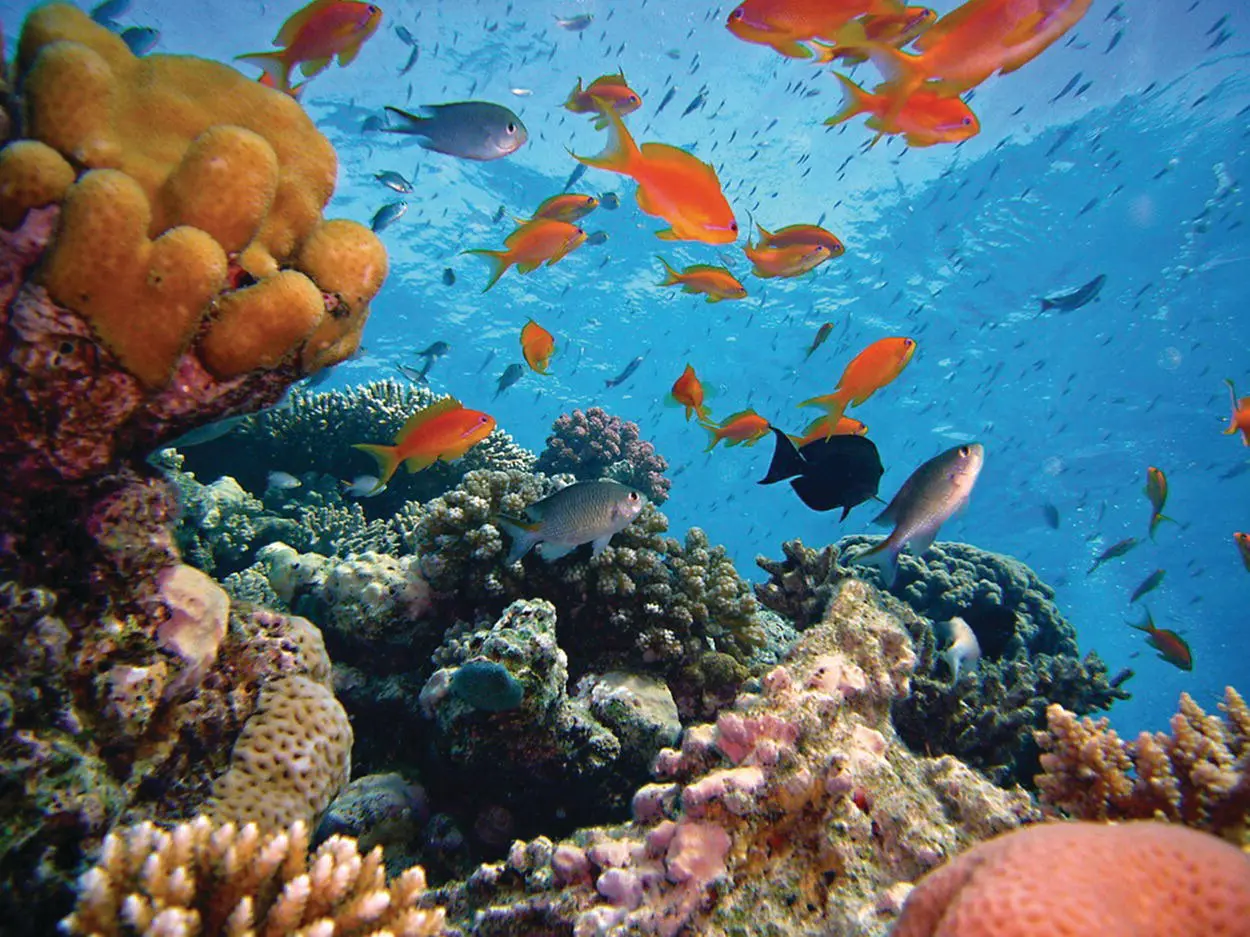
Figure 2.1 There are few places where biodiversity is as conspicuous as a coral reef.
(Hans Chehaiber/Flickr/CC BY 1.0)
Читать дальше
